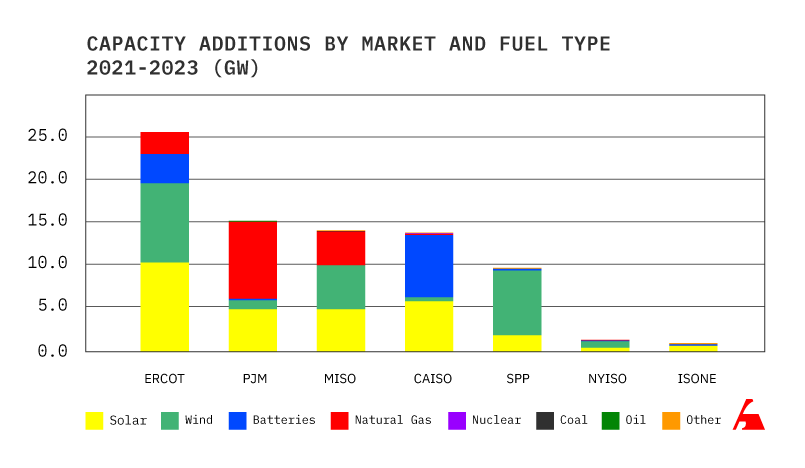After a new generator is built, it must be plugged into the rest of the grid before it is able to power homes and compete against existing generation to keep prices low. The process of plugging in a new generator is known as “interconnection.” Unfortunately, the interconnection process takes too long, about 5 years on average.1 Only about one in five projects even survives the gauntlet. Despite this broken system, there are more than 350 gigawatts of potential generation capacity likely to be interconnected–far more than AI is expected to demand.2
The red tape to connect to the electrical grid must be cut to promote affordable electricity and meet the demands of artificial intelligence alongside American industry.
Scholars and the Government Accountability Office have identified problems in electricity markets that slow down connecting generation to the electrical grid. Only Texas seems immune to this challenge, connecting more new capacity and a wider variety of sources than any other grid.3

As changes to the Inflation Reduction Act’s subsidies occur, the makeup of these additions will likely shift as subsidies end for renewable sources. The demands of AI have also spurred interest in natural gas projects. Regardless of energy source, however, only in Texas will these projects be quickly connected to the electrical grid to power said data centers.
A major problem for several major electricity markets today are their bloated planning systems, known as capacity markets. The three grids in the eastern US that serve customers from Virginia up to Maine are chief examples of struggling capacity markets. Texas is a leading energy-only market. These capacity markets are a chief cause of delay in interconnection and function more like Soviet-style central planning than real markets. They attempt to reserve electricity capacity for days when demand will be incredibly high. Yet, these are poorly administered and fail to promote serving customers when they actually want electricity.
A better system, like Texas’s, would simply rely on electricity prices to direct investment. Though capacity systems and price systems are the same in the world of blackboard energy economics, the real world has proven too complicated for capacity solutions.4
To improve the operation of electrical grids, policymakers have many options. Here are the top recommendations:
- Encourage regional grids to move towards Texas-style operations.
- Direct grid operators to employ automation and artificial intelligence in expediting interconnection studies.5
- Direct the Federal Energy Regulatory Commission (FERC) to adopt cost-effective network upgrades and include the role of regional transmission planning.6
- Direct FERC to host a technical conference and related rulemaking on interconnection rules and the barriers that capacity markets create to quickly connecting more generation capacity.
- As part of this conference and rulemaking, FERC must investigate the economic foundations of capacity markets to set boundaries on their operations in practice. The goal is to replace bloated planning with market-driven investments that encourage efficiency, adaptation, and innovation.
- Require FERC to submit annual reports on interconnection timelines and how they are speeding up these timelines.
- Pass an all-of-the-above permitting reform bill to speed the building of transmission and generation.7
The key to low-cost energy that is widely accessible to all is having lots of electricity generators to serve customers. Interconnection processes keep electricity prices high by slowing the addition of new generators just as barriers to new grocery stores would keep food prices high. If Congress enacts rules like these, it will reduce energy costs for the entire country.
1 Joseph Rand et al., “Characteristics of Power Plants Seeking Transmission Interconnection As of the End of 2023” (Lawrence Berkeley National Laboratory, April 2024), https://emp.lbl.gov/queues.
2 Alex Trembath and Josh T. Smith, “Abundance Will Meet the Energy Demands of AI,” Heatmap News, October 15, 2024, https://heatmap.news/ideas/abundance-additionality-permitting-reform.
3 Tyler H. Norris, “Pre-Workshop Comments and Exhibit of Tyler H. Norris of Duke University,” Pre-workshop Comments AD24-9-000, September 2024, https://nicholasinstitute.duke.edu/publications/comments-ferc-workshop-innovations-efficiencies-generator-interconnection; Tyler H. Norris, “Beyond FERC Order 2023: Considerations on Deep Interconnection Reform” (Duke University Nicholas Institute for Energy, Environment, and Sustainability, August 2023), https://nicholasinstitute.duke.edu/sites/default/files/publications/beyond-ferc-order-2023-considerations-deep-interconnection-reform.pdf.
4 Todd Aagaard and Andrew N. Kleit, Electricity Capacity Markets (Cambridge, United Kingdom New York, NY: Cambridge University Press, 2022); Todd S Aagaard and Andrew N Kleit, “The Complexity Dilemma in Policy Market Design,” Duke Environmental Law & Policy Forum, 2019.
5 Devin Hartman and Beth Garza, “Finishing Generator Interconnection Reform” (R Street Institute, December 5, 2023), https://www.rstreet.org/commentary/finishing-generator-interconnection-reform/.
6 Hartman and Garza.
7 Josh T. Smith, “Facilitate an All-of-the-Above Energy Strategy for Energy Abundance,” (Abundance Institute, April 2025), https://abundance.institute/articles/all-of-the-above-energy.